Song for Pyrola uniflora
I came upon her lonely in the wood,
With downbent head she gazed upon the moss
Green-carpeting the forest where she stood
Under the pine tree’s boss.
Waxen her cheek as some pale-lidded shell
Returning tides have stranded unaware,
Her breath as faintly fragrant as the spell
A passing angel left upon the air.
Strange destiny! Fair treasure-trove unsought,
Undreamed-of at the breaking of the day,
How rich this hour that has so quietly brought
Such masterpiece my way.
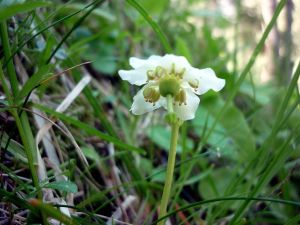
In 1933, a remarkable woman was travelling the lands of the Arctic, blissfully independent, in search of the wild flowers that grow there. She was so enraptured by her delicate finds that she was often inspired to write poetry about them. She was a botanist, a writer, an artist, and a photographer… but perhaps most importantly she was a free spirit. Her name was Isobel Wylie Hutchison.

One of five children, Isobel was born in 1889 at Carlowrie Castle in West Lothian. She had a loving, carefree childhood and indulged her talent for poetry, helping to edit a family magazine and keeping regular journals. But her father died suddenly when she was 10, and before she was 20 she had lost both her brothers: one while climbing in the Cairngorms, and the other during the Great War. Taking her grief deep into her heart, Isobel found solace in walking, either alone or in the company of her sisters.
Isobel trained in horticulture at Studley College in Warwickshire, and it was her love of botany that opened the door to her life of adventure. Her mother was busy organising dinner parties with eligible naval cadets, but Isobel had no intention of settling down to a life of domestic boredom. Having made many long-distance treks across Scotland, she was ready to spread her wings and fly further. The lands of the north, remote and serene with their sparkling snowfields and deep blue fjords, had always held a special attraction for her, and instinctively she followed her heart.
Iceland, which she visited in 1925, was both a test and a revelation. Having been told that she couldn’t walk from Reykjavik to Akureyri in the north, a distance of 260 miles, because there were no maps, no guides, and it was far too dangerous, Isobel proved everyone wrong and then set her sights on another goal: Greenland. She would have to wait nearly two years for permission to travel there, but when she walked down the gangplank at Angmagssalik in August 1927, she thought it highly likely that she was the first Scotswoman ever to set foot there.
“Thirty-eight years of formally correct life at Carlowrie had made Isobel an aloof observer; it would take time and effort for her to break down the barriers and become a full participant.”
‘Flowers in the Snow’ by Gwyneth Hoyle
Isobel had a lot of learning to do, but her soul opened out in response to the Greenlanders’ simple curiosity, as perhaps it never had in her native Scotland. Welcomed into their houses, she was struck by their poverty and their touching gratitude at her small gifts; she made her first attempts at speaking Greenlandic, joined in their dances, watched them sew and cook, and quickly learned that their thick sealskin trousers were not only decorative but an essential means of protection against biting insects. She purchased a pair, and was photographed proudly modelling them. You can imagine her sense of jubilation and freedom.
Returning to Carlowrie on Christmas morning, 1927, Isobel was radiating a joyful new purpose. She was also penniless, but she started to write about her travels and it wasn’t long before her articles and poems were beginning to bring her a well-deserved income. She read some of her poems aloud on BBC radio, and was interviewed for the Daily Post. But true voyagers never settle, and when she wrote in her diary that it was “as though she had never been away”, her wistfulness was hiding between the words. Just over six months later she was back at sea, heading for a settlement in northern Greenland, above the Arctic Circle.
“It was rare for explorers to encounter a woman who had firsthand knowledge of the landscape, the people, and the conditions of life in the North. She projected an immediate empathy that fully engaged their attention.”
‘Flowers in the Snow’ by Gwyneth Hoyle
In the 1920s, polar exploration was still very much a masculine domain. The South Pole had been reached in 1911 by Roald Amundsen, and soon afterwards Antarctica claimed the lives of Robert Falcon Scott and his four companions. Shackleton had died on board the Quest off South Georgia in 1922. As for the North Pole, the highly flammable Cook-Peary controversy had blown up in 1909, and the question of whether either of them had actually reached the Pole was still simmering. The polar regions, whether north or south, were not for the faint-hearted.
A woman willing to tackle such an environment was an unusual and almost scandalous phenomenon, and although she had no intention of trying to reach the North Pole, Isobel was still risking even more than she knew. It was a rough and ruthless environment, where only the hardiest souls could thrive. But all the Arctic traders and navigators she met seemed to sense a kindred spirit on first meeting, as if the fire was visible to them beneath the skin. Unknowingly, through her words and her bearing, Isobel invited respect, and she received it.

In particular, Isobel won the admiration of the polar explorer Knud Rasmussen, whom she met on several occasions and who visited her at Carlowrie with his family in 1928. In Greenland, it was Rasmussen who helped her with introductions to far-flung communities, easing her path and ensuring that she was known, at least by repute, before she arrived. It wasn’t much, but when she got there in person her friendliness and increasing adaptability did the rest.
And then there was Gus Masik.
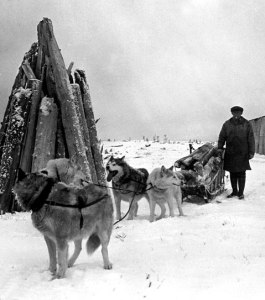
A rugged Estonian who could turn his hand to anything from mining to boat-building, Gus had run away to sea aged 17, and had found a place with Vilhjalmur Stefansson on the Canadian Arctic Expedition. Stefansson had been so impressed with Masik that he said, “There is no man who has been with me in my Arctic work in a non-scientific capacity whom I would rather have with me again.” Gus was now a fur trader and prospector, with a reputation for single-minded independence; if life became too easy, his restless spirit moved him on. Six months older than Isobel, he had more in common with her than it first appeared.
It was in Alaska, in September 1933, that Isobel first encountered Gus’s candid blue-eyed gaze. This was her most ambitious adventure: she had already roughed it in all kinds of rusting and stinking vessels, all the way up from the Panama Canal to Vancouver and beyond. At Barrow the sea was rapidly freezing, and Gus took her on board his boat, the Hazel, fleeing east along Alaska’s northern coast while the passage was still open. At Martin Point, on a snow-covered sandspit about a mile long by a hundred yards wide, Gus lived in a simple one-roomed cabin, and Isobel found herself marooned there until the ice became thick enough for sledging.
“You took an awful chance travelling alone in these parts!…”
“I never take any chances,” I said quite sincerely. “God always blazes my trail. I should not be here now if He hadn’t.”
‘North to the Rime-ringed Sun’ by Isobel Wylie Hutchison
With a family of Inuit people as their only neighbours, and no contact whatsoever with the outside world, all kinds of assumptions could have been made about Gus and Isobel’s relationship, and Isobel was acutely aware of it. Nor would history have judged her as critically as her contemporaries. But she set strong physical boundaries, making it quite plain that friendship was all she was offering. For seven weeks she stayed with Gus, giving herself chores in the daytime and listening to his tales of adventure at night. To his amusement, every day she would take one or two of his sledge dogs for a walk on a leash, to the end of the island and back. Her painting of the inside of Gus’s cabin, with Gus seated on a box and playing some kind of accordion, reminds me of an illustration in an Enid Blyton book: everything is tidy, clean, wholesome looking, with cheerful colours and no dark corners.
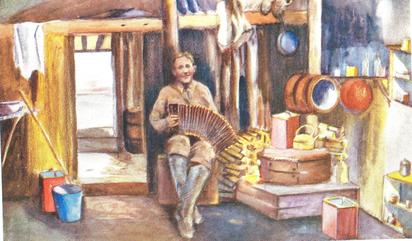
Isobel’s next destination was Aklavik in Canada, so Gus took her eastwards by dog sled as far as Herschel Island, a journey that lasted several days. When no cabins were available he built a snow house for their overnight accommodation, which Isobel found much more cosy than her flimsy tent. Crawling inside through the small entrance hole, she looked up to see the walls and roof sparkling like diamonds in the candlelight. Gus’s words on board the Hazel must have come back to her: “Not many have seen what you are seeing!” (‘North to the Rime-ringed Sun’)
And the skies that Isobel slept under were nothing short of incredible. Just before they left Sandspit Island, Gus roused her from sleep and urged her to come and look at the moon, which was setting in the west, blood-red, “as large as a rising sun. To eastward the sky on the horizon was a faint rose with saffron shading to blue above, and a star or two still clear in the emerald zenith.” (‘North to the Rime-ringed Sun’)
Isobel was treading through little-known landscapes, and even if whalers and explorers had seen them before her, none had viewed them through the eyes of a naturalist. When she came home she would go on a dizzy round of lectures, sharing her findings with many academic organisations, including the Royal Scottish Geographical Society. But, like a migrating bird, the north would soon draw her again like a magnet, and she would be off to the land of sparkling snows and dancing lights.

She did her job brilliantly well, as she did everything. She collected thousands of plant specimens, preserved and labelled them, and despatched regular parcels by ship to the British Museum. She examined historical sites, traded with the Inuit people, and accepted their hospitality with general cheerfulness and a remarkable constitution. She expressed the beauty of what she saw in poetry, prose and paintings, and she filmed the people of the Arctic as they went about their daily lives.
“Up and on I climbed, filling my press with specimens, trailing white saxifrage, whose bright-green cushion made a rock-garden out of the slopes above a little stream golden with mimulus, and covered the mossy hollow where a bird had made her nest and laid in it four blue eggs… The constant hush of the air in the spruce boughs was like the sound of falling water.”
Travelling in the Aleutians, from ‘Stepping Stones from Alaska to Asia’ by Isobel Wylie Hutchison
I can’t help considering Isobel in comparison with Isabella Bird. Both had the same wandering spirit that knew no rest; both sought temporary companionship with a rugged pioneer who was living alone and on the edge. Isabella, on the face of it, seems more hard-boiled, ready to wield a gun or a saucepan in self-defence; Isobel, on the other hand, hid her vulnerability behind a wall of ice. As her biographer, Gwyneth Hoyle, suggests, Isobel was like a pure Arctic flower, destined to bloom brilliantly and alone.
She certainly had some spirit, though…
One of the more spooky phenomena of the Arctic seas was a ‘ghost ship’, which would occasionally drift into sight and cause a great deal of excitement among even the toughest seamen. Her name was the Baychimo, and she was in fact a former supply vessel of the Hudson’s Bay Company that had been abandoned by her crew when she was engulfed by ice near Point Barrow in 1931. The crew made it back to shore, but during a two-day blizzard the Baychimo mysteriously disappeared, leaving a mountain of cracked ice 100 feet high. For years afterwards she was glimpsed occasionally, still caught fast in an ice pack, sailing the waters of the Arctic Ocean like the Marie Celeste, creaking in eerie emptiness with no one at the helm.

In 1933 the Trader, a small schooner which was carrying Isobel northwards, came alongside the Baychimo, and several of the crew scrambled over the ice and boarded her. Nothing daunted, Isobel followed them up the broken ladder. What she saw both fascinated and spooked her:
“All was as silent as the grave. In the deserted saloon a table stood ready set with cups and saucers for a meal. A breakfast menu lay nearby. In the captain’s cabin charts were scattered about in haphazard disarray. Here and there in the hold sacks of old furs and other cargo were piled in heaps or propped against the walls. In one corner there were several rusted but unused typewriters.”
‘The Scotsman’, 2nd November 1939
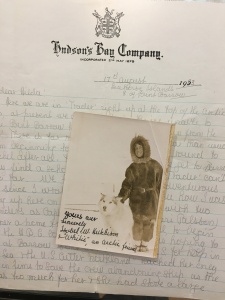 While the men salvaged a few things that they could sell, Isobel picked up a handful of writing paper adorned with the emblem of the Hudson’s Bay Company, astonishingly still in good condition. Back on the Trader, she used it to write to her sister:
While the men salvaged a few things that they could sell, Isobel picked up a handful of writing paper adorned with the emblem of the Hudson’s Bay Company, astonishingly still in good condition. Back on the Trader, she used it to write to her sister:
“I got a lot of this HBC notepaper on which I am writing you! Also some charts, nugget polish, British flags, and odds and ends including films which still seem quite good, but unluckily don’t quite fit my camera! Most of the valuable cargo had already been removed, but Pete and Kari [Palsson] got the ship’s compass… it was a most exciting and uncommon adventure… ”
Letter dated 17th August 1933 (RSGS archives)
Describing her passage on the Trader, she revealed: “The three men on board are awfully decent fellows… I’m getting quite handy at knowing how to make stew out of cans… My one regret is a hot bath.”
Of all the messages written by intrepid travellers from far-flung locations, a letter from a ghost ship has got to be one of the most extraordinary. As Isobel herself says, with remarkable understatement, “Golly! I will have lots to tell if I ever get home again!” (RSGS Archives)
(Out of interest, the Baychimo continued her silent voyage until at least 1969, which was the last sighting recorded in the Hudson’s Bay Archives.)
The fact that Isobel gained comparatively little recognition for her mental and physical endurance is partly down to her distaste for drama: she played down the hardships and the discomforts, although she endured them all. It would, of course, have been easier if she had been trying to do something newsworthy, like crossing the Arctic on foot; in the harsh footlights of posterity, plant collecting didn’t quite cut the mustard.
The interesting thing about Isobel is that, inside the well-ordered mind of a respectable woman were the instincts of a truly wild child. Her Arctic adventures were an escape in more ways than one. In the early decades of the 20th century women in Britain were still taking their first tentative steps towards equality, and it wasn’t until 1928 that all women over 21 were entitled to vote. For Isobel, who delighted in travelling wherever her spirit took her and befriended whom she wished, the society that she returned to every time at Carlowrie must have seemed stifling. She never married, and it’s tempting to wonder if her solitary travels were prompted by a feeling of being an outsider, an “onlooker” as she put it. But I feel that it might go a lot deeper than this. The title of one of her early compositions, ‘The Calling of Bride’, suggests a kind of enlightenment, and indeed she suffered a period of prolonged depression in 1920, followed by a moment of profound revelation, as if waking from a dream. She spent that winter in a kind of spiritual recuperation on the Isle of Tiree, and from there she gained the confidence to set forth on her own path. Had she been born in a later era, how different her life might have been: but perhaps, had she not had the oppression to push against, the door might never have opened. It is the friction that supplies the spark.
“The man who confides his course to Providence is always sure of adventure – always sure to find that Heaven’s ways are infinitely more interesting and adventurous than his own plans!”
‘North to the Rime-ringed Sun’
Isobel seems to have been a fascinating blend of gentleness, determination, spontaneity, modesty, primness and irrepressible optimism. She certainly had faith in a powerful but unseen guiding presence, watching over her adventures. And she forged some warm and lasting friendships: perhaps the closest to her heart was Gus Masik, whom she saw twice more after he drove away from Herschel Island behind his dog team, and they kept in touch by letter until Gus died in 1976.
What a legacy Isobel left behind her. She collected plant specimens for the Royal Botanic Gardens in Kew and Edinburgh, and for the British Museum; many of the artefacts that she brought back from her travels can be seen in the National Museum of Scotland, and the National Library of Scotland holds many of her papers and drawings. Other treasures are held in the Cambridge University Museum of Archaeology and Anthropology and in the Scott Polar Research Institute. The Royal Scottish Geographical Society has a varied collection of Isobel’s slides, films, poetry, paintings, broadcast scripts, notes and books. She was honoured with the Mungo Park Medal of the RSGS in 1934, and was both a Fellow and Vice-President of the Society. She died at Carlowrie in 1982.
I’ve found the way to Fairyland,
The secret path and straight,
Red rowan berries hedge about
Its long unopened gate…”
Sources and reference:
Poem: ‘Song for Pyrola uniflora’ from ‘Stepping Stones from Alaska to Asia‘ by Isobel Wylie Hutchison
Poem: ‘I’ve found the way to Fairyland…‘ from ‘On Greenland’s Closed Shore‘ by Isobel Wylie Hutchison
– ‘Flowers in the Snow‘ by Gwyneth Hoyle
Books by Isobel Wylie Hutchison:
– ‘North to the Rime-ringed Sun’
– ‘On Greenland’s Closed Shore’
– ‘Stepping Stones from Alaska to Asia’
Manuscripts and news cuttings in RSGS archives
Quotes from Isobel’s letter dated 17th August 1933, reproduced courtesy of the RSGS; image of it (together with signed photograph of Isobel) taken by Jo Woolf with kind permission of RSGS. Thanks also to the RSGS for allowing me to reproduce a number of other b&w photos from Isobel’s collection.
Thanks to the National Library of Scotland for allowing me to reproduce Isobel’s drawing of Gus Masik.
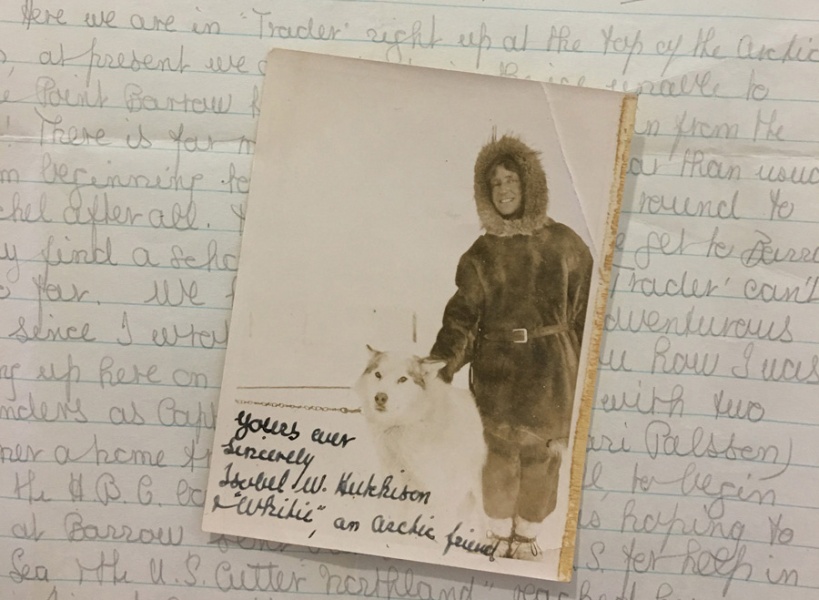
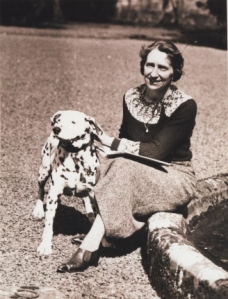

Fascinating lady! Thanks, Jo. What drives these women, and men for that matter, is quite beyond me. But I do enjoy hearing about there travels.
LikeLiked by 1 person
It’s always fascinating to try and get a glimpse of their character, Pat. Having written about so many explorers now, it’s interesting to compare them. Many similarities, but all are essentially unique. You’re very welcome, glad you enjoyed it! 🙂
LikeLike
I had never heard of this remarkable woman, thank you for enlightening me. She must have had extraordinary courage and determination to travel to such wild and forbidding places. I’ve travelled from Reyjkavik to Akureyri and it was adventure enough in the comfort of a 4-wheel drive with a companion who had done it before; the thought of walking that route alone without knowing what it would entail quite takes my breath away. As for Greenland, that’s even more extreme. It’s a place I’d love to visit but I’d be quite nervous about it, even armed with lots of information, photos, maps, etc. It sounds as if she had an overpowering desire to challenge herself, and she was prepared to put aside issues of comfort and control to push herself to her limits. She must have had to rely on the hospitality of others a great deal, especially in Greenland. The relationship she had with Gus is intriguing. Her life story could make a beautiful film, with the picturesque backdrops of Arctic landscapes and scenes set in Carlowrie Castle.
LikeLiked by 1 person
I hadn’t heard of Isobel before either, Lorna, and yet she made such a huge contribution to our knowledge of the Arctic – its landscape, flowers and culture. In fact when I went to the National Museum in Edinburgh a few months ago, the first things I saw were some exhibits donated by Isobel Wylie Hutchison! You are better placed than me to judge the journey from Reykjavik to Akureyri, and it sounds gruelling even now. But yes, she did have this happy habit of finding welcoming people to stay with, wherever she was, whether it was Scotland or Greenland or right up on the north coast of Alaska. She didn’t mind what she ate either, taking the attitude of ‘I’ll have what you’re having’ – great if you don’t mind that a frozen caribou carcass in the shrouds of the ship is the source of breakfast, lunch and dinner! And a bathroom that consisted of a bucket. I would have said more than “Golly!”, that’s for sure! I was putting off writing about Isobel, as I had a sinking feeling that it would be mostly about the science and not much about the person, but I have such a respect for her now and it was wonderful to hold the letter that she wrote to her sister, and see her rounded schoolgirl-type handwriting. Her writing reveals a lot about her, as her biographer, Gwyneth Hoyle, says. That is a very good point about a film of Isobel’s life. I hope someone makes one sometime! For myself, there are certainly more stories here, ready to be told. I love finding people like this! 🙂
LikeLike
That must have astonished you in the museum, it’s funny the way things pop into your life like buses all coming along at once. Good point about the food and hygiene aspects, they would put most people off I think. You did a terrific job of telling her story, I enjoyed it very much from start to finish.
LikeLiked by 1 person
It certainly made me smile! Thank you so much – very kind. It was a pleasure to write about Isobel, as you can probably tell! 🙂
LikeLike
What a fascinating woman Jo. Thanks for bringing her to our attention.
LikeLiked by 1 person
Most welcome, Susan. I am glad you find her as interesting as I do!
LikeLiked by 1 person
Dear Jo Woolf, thanks very much for this interesting account. Do you happen to know whether her diaries have survived and whether it is possible to read them? I would love to know that.
LikeLiked by 1 person
Hi Carina, I’m glad you enjoyed reading about Isobel! Yes, some of her journals have survived but are in different places and collections, e.g. at the National Library of Scotland and the RSGS. If you’d like to read more the best thing would be to try and get hold of her books, as they are delightful accounts, although they can be difficult to find. For example, ‘North to the Rime-ringed Sun’, and ‘On Greenland’s Closed Shore’ – beautifully written (in the style of a journal), and very readable.
LikeLike
Hi Jo
I have just read the interesting article about Isobel Wylie Hutchison in the Herald on Sunday on 21/12/18. Just wanted you to know that I teach classes on Scottish Women’s History for the City of Edinburgh Adult education programme and for the last five years have run a course on “Inspirational Women” in which I included Isobel and her travels, so she hasn’t been completely forgotten. Many of my former students now know about her and were astonished by her courage and daring at a time when women were supposed to conform!
Best wishes
Jane George
LikeLiked by 1 person
Hi Jane, how lovely to hear from you and I’m delighted to know that you include Isobel in your course on Inspirational Women. Fantastic that you’re spreading the word about her! We should be so proud of her achievements, and I’m glad because I feel her spirit is being more widely appreciated, through the efforts of yourself and also (as you’ve read in the Herald) through the event taking place at Carlowrie Castle this week.
Your course sounds very interesting. RSGS holds a lot of information and material relating to Isobel, and if we can be of any help, please let me know. There are also many other women explorers whose stories have been overlooked – you’ve probably seen some of them on here! If you’d like to discuss any ideas, you’re most welcome to drop me an email – jo@thehazeltree.co.uk Meanwhile thank you again for getting in touch. With best wishes, Jo
LikeLike